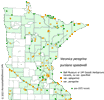Veronica peregrina (Purslane Speedwell)
| Also known as: | Neckweed |
|---|---|
| Genus: | Veronica |
| Family: | Plantaginaceae (Plantain) |
| Life cycle: | annual |
| Origin: | native |
| Habitat: | part shade, sun; moist disturbed soil; lawns, roadsides, waste areas |
| Bloom season: | May - October |
| Plant height: | 3 to 12 inches |
| Wetland Indicator Status: | GP: FACW MW: FACW NCNE: FAC |
| MN county distribution (click map to enlarge): |  |
| National distribution (click map to enlarge): |  |
Pick an image for a larger view. See the glossary for icon descriptions.
Detailed Information
Flower: 


![[photo of flowers]](/udata/r9ndp23q/pd/veronica-peregrina-all-15-t.jpg) Short-stalked flowers in loose racemes on branching stems, open for a short period mid-day. Flowers are tubular, less than 1/8 inch across, with four oval to round petal-like lobes; the upper can be slightly larger and the lower slightly smaller, but often they are all nearly equal in size. Typically white but may have a pinkish cast. Behind the flower and alternating with the petals are 4 green sepals about as long as the petals. At the base of the flower stalk is a leaf-like bract, so it appears the flowers arise from leaf axils. The flowers wilt rather quickly and fall away to be replaced by other flowers the next day.
Short-stalked flowers in loose racemes on branching stems, open for a short period mid-day. Flowers are tubular, less than 1/8 inch across, with four oval to round petal-like lobes; the upper can be slightly larger and the lower slightly smaller, but often they are all nearly equal in size. Typically white but may have a pinkish cast. Behind the flower and alternating with the petals are 4 green sepals about as long as the petals. At the base of the flower stalk is a leaf-like bract, so it appears the flowers arise from leaf axils. The flowers wilt rather quickly and fall away to be replaced by other flowers the next day.
Leaves and stems: 


![[photo of leaves]](/udata/r9ndp23q/pd/veronica-peregrina-all-26-t.jpg) Lower leaves are up to ¾ inch long and 1/3 inch wide, opposite, oblong with a blunt tip, mostly stalkless except for the lowest leaves, often with a few widely spaced teeth but may be toothless, becoming smaller, narrower, toothless, alternate floral bracts on the upper stem. Branches form on the basal stem, producing dense, erect masses. Stems are sometimes purplish, can be smooth or have fine, short hairs, but leaves are typically smooth throughout.
Lower leaves are up to ¾ inch long and 1/3 inch wide, opposite, oblong with a blunt tip, mostly stalkless except for the lowest leaves, often with a few widely spaced teeth but may be toothless, becoming smaller, narrower, toothless, alternate floral bracts on the upper stem. Branches form on the basal stem, producing dense, erect masses. Stems are sometimes purplish, can be smooth or have fine, short hairs, but leaves are typically smooth throughout.
Fruit: 
![[photo of fruit]](/udata/r9ndp23q/pd/veronica-peregrina-all-22-t.jpg) Fruits are heart shaped, shorter than the sepals, and may have fine hairs along the edges.
Fruits are heart shaped, shorter than the sepals, and may have fine hairs along the edges.
Notes:
Native to much of both hemispheres of the New World, Purslane Speedwell has also become widespread as a weedy species in the Old World. It is a common weed in gardens and disturbed sites with adequate moisture, even in planter boxes. There are two common varieties, both found in Minnesota: var. xalapensis has fine hairs on stems, fruits and sepals, and var. peregrina is hairless throughout.
Native Plant Nurseries, Restoration and Landscaping Services ↓
More photos
Photos by Peter M. Dziuk taken in Anoka County.
Comments
Have you seen this plant in Minnesota, or have any other comments about it?







 Purslane Speedwell plant
Purslane Speedwell plant more plants
more plants plant with purple stem
plant with purple stem